An invasive species is a non-native organism that has been introduced to an ecosystem and causes harm to the environment, economy, or human health. These species often have no natural predators in their new habitat, allowing them to reproduce rapidly and compete with native flora and fauna for resources.
Invasive species can cause significant economic damage by reducing crop yields, damaging infrastructure such as buildings or roads, and increasing management costs for public lands. Additionally, some invasive species are known carriers of diseases that can be harmful to humans or other animals.
In Indiana specifically, there are several invasive plant and animal species that pose a threat to the state’s ecosystems. It is important for individuals to stay informed about invasive species in their area so they can take measures to prevent their spread and protect local biodiversity. For a complete list of invasive species, see the listing here.
1. Asian Marshweed

Asian Marshweed is an invasive aquatic plant in Indiana.
©Maciej Maciejowski/Shutterstock.com
Asian Marshweed, also known as Limnophila sessiliflora, is an invasive plant species that originated from Southeast Asia. It was first introduced to the United States in the 1930s and has since spread rapidly across various states, including Indiana. The plant can grow up to two meters tall and thrives in wetland areas such as marshes, ponds, and slow-moving streams.
One of the reasons why Asian Marshweed is considered a threat is its ability to outcompete native plants for resources such as light and nutrients. This can lead to a reduction in biodiversity within these ecosystems. Additionally, this invasive species can form dense mats on the water surface, which may impede navigation and recreation activities.
Efforts are being made by organizations such as the Indiana Department of Natural Resources (DNR) to control the spread of Asian Marshweed through management techniques such as physical removal and herbicide treatment. However, it remains important for individuals who encounter this invasive species to report their sightings to local authorities so that appropriate action can be taken promptly.
2. Brittle Water Nymph
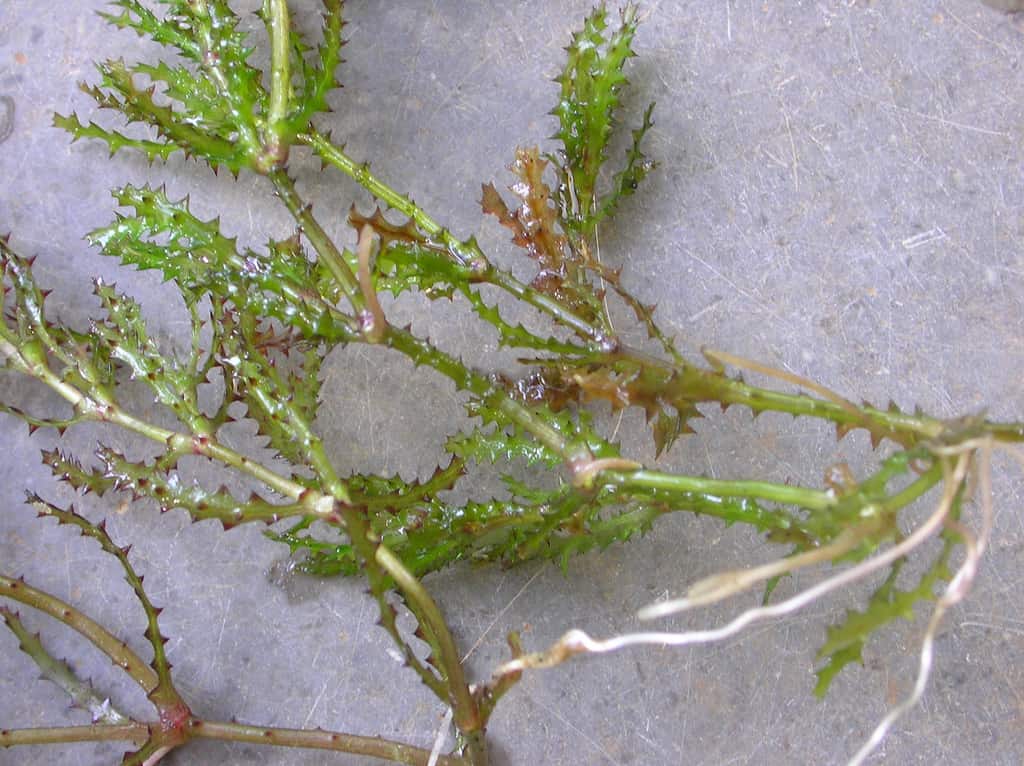
Brittle Water Nymph is an invasive species. Its scientific name is Najas Minor.
©Lalithamba from India, CC BY 2.0 – License
Brittle water nymph, also known as Najas minor, is an invasive species that has become a growing concern in Indiana. This floating plant with submersed roots and slender branching stems has been causing significant damage to aquatic ecosystems across North America. While it is unclear how this species was introduced to the continent, it is believed that its seeds are likely transported via waterfowl, boats, or boat trailers.
One of the biggest problems associated with brittle water nymphs is their ability to form dense monospecific stands in shallow waters. These thick mats of vegetation can inhibit the growth of native species and hinder recreational activities such as fishing, swimming, boating, and other forms of water contact recreation. Furthermore, these stands can also alter habitat conditions for fish and other aquatic organisms by changing light levels and oxygen concentrations.
Despite efforts to control the spread of brittle water nymphs through mechanical removal or herbicides, this invasive species remains a persistent threat in many regions throughout Indiana and beyond. It serves as a reminder of just how easy it can be for non-native plants to cause irreparable harm to our local environments when they are not properly managed or controlled.
3. Chinese Water Spinach

Swamp morning glory or Chinese water spinach invasive species disrupts the balance of local flora and fauna in Indiana.
©spndpatty/Shutterstock.com
Chinese water spinach, commonly referred to as Ipomoea aquatic or swamp morning glory, is an invasive species that poses a significant threat to the native ecosystems of Indiana. This plant is primarily found in wetlands and along river banks, where it thrives due to its ability to grow rapidly and outcompete native vegetation for resources such as sunlight and nutrients.
Also known as “Kang kong” in some cultures, Chinese water spinach has thick stems with succulent leaves that can range in size from small to large. Its flowers are typically white or pinkish-purple and bloom during the summer months. While this plant may seem harmless at first glance, it can have devastating effects on the biodiversity of an ecosystem if left unchecked.
The spread of Chinese water spinach is often facilitated by human activity, such as dumping aquariums or intentionally planting it for consumption purposes. However, once established in a new area, this invasive species can quickly take over and disrupt the balance of local flora and fauna.
4. Duck Lettuce

Duck Lettuce is an invasive aquatic plant that grows rapidly.
©feathercollector/Shutterstock.com
Duck lettuce, scientifically known as Ottelia alismoides, is an aquatic plant commonly found in slow-moving or still waters such as ponds and lakes. The plant has long stems with leaves that can survive being totally submerged under the water. Its leaves are oval-shaped with a pointed tip and can vary in size from 2-16 cm long.
Despite its name, duck lettuce is not related to any type of lettuce. The plant’s invasive nature makes it a threat to native aquatic species and ecosystems. Duck lettuce grows rapidly and can quickly cover large areas of water.
5. Flowering Rush
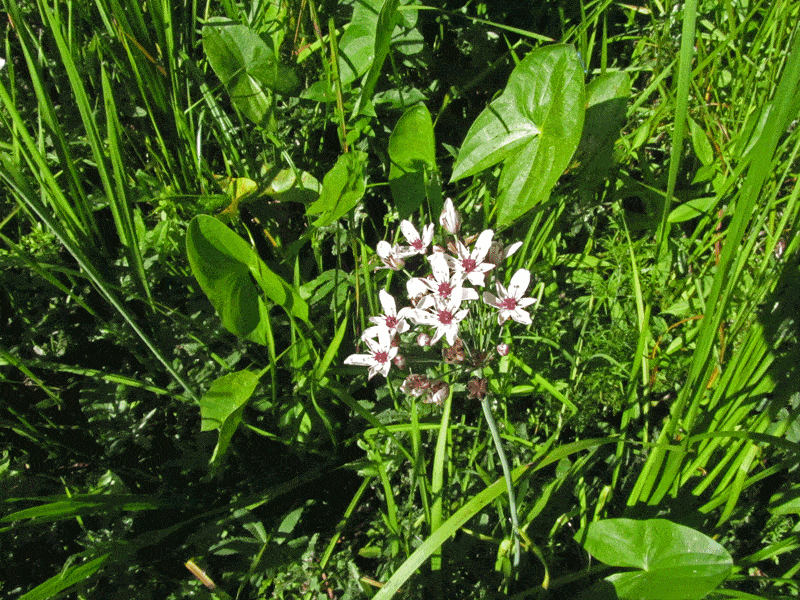
Flowering Rush, Butomus umbellatus, is an invasive species.
©Homer Edward Price, CC BY 2.0 – License
The flowering rush is an aquatic perennial plant that belongs to the family of flowering plants called Butomaceae. It typically grows in shallow waters, such as marshes and wetlands, but can also be found in lakes, rivers, and streams. The plant has long stems with narrow leaves that grow from a basal rosette at the bottom of the stem. Atop each stem sits a pink or white umbel-shaped flower cluster that blooms from mid to late summer.
While it may seem like a beautiful addition to any body of water, the flowering rush is actually considered an invasive species in Indiana due to its ability to rapidly spread and crowd out native vegetation. Its dense root system can make it difficult for other plants to survive, disrupting entire ecosystems. Additionally, when left unchecked, this non-native species can cause problems for boaters and fishermen as it clogs up waterways and interferes with recreational activities.
Efforts are underway across Indiana to control the spread of the flowering rush by removing existing populations and preventing new ones from taking hold. This includes everything from manual removal efforts by volunteers to targeted herbicide applications by trained professionals. While progress has been made in some areas towards eradicating this invasive plant species altogether, continued vigilance will be necessary in order to fully protect our state’s natural resources from its harmful effects.
6. Asiatic Clam
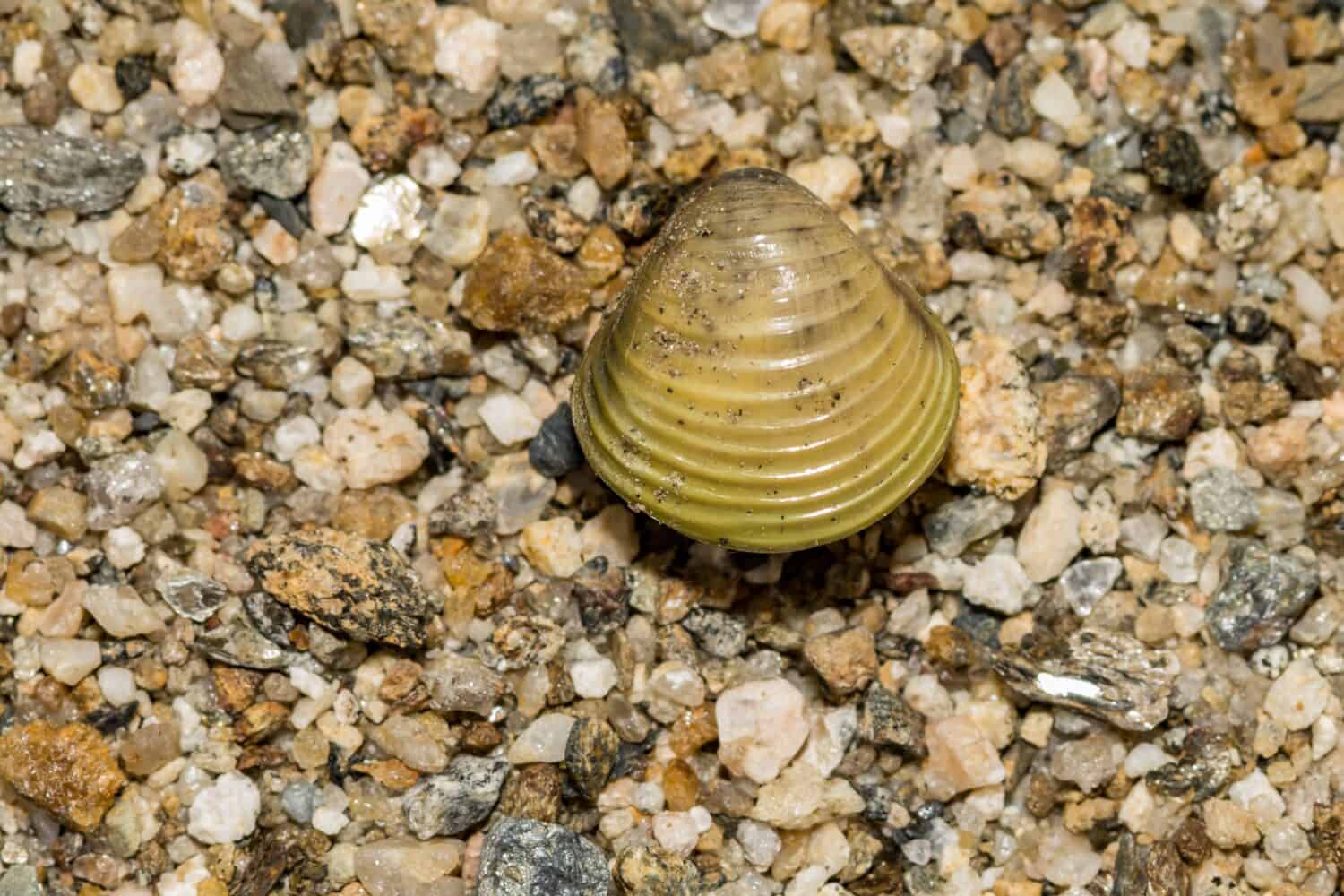
Asiatic clams negatively impact water quality and cause property damage.
©Jay Ondreicka/Shutterstock.com
An Asiatic clam (Corbicula fluminea) is an invasive species that has become a major problem in Indiana’s freshwater ecosystems. Originally from Southeast Asia, these small bivalve mollusks were introduced to the United States through the aquarium trade and ballast water discharge from ships. They are now found in rivers, lakes, and streams throughout Indiana.
Asiatic clams reproduce rapidly and can quickly overtake native species by outcompeting them for food and habitat resources. They also have a negative impact on water quality as they excrete nitrogen that causes algae to overgrow.
In addition to their ecological impacts, Asiatic clams also cause millions of dollars in property damage by clocking up water systems, pipes, and canals.
Efforts are being made to control the spread of Asiatic clams in Indiana through measures such as monitoring populations, educating the public about preventing their spread through recreational activities like boating and fishing, and implementing regulations on ballast water discharge from ships. However, eradicating this invasive species completely remains a challenge due to their high reproductive rate and ability to adapt to changing environments.
7. Quagga Mussel
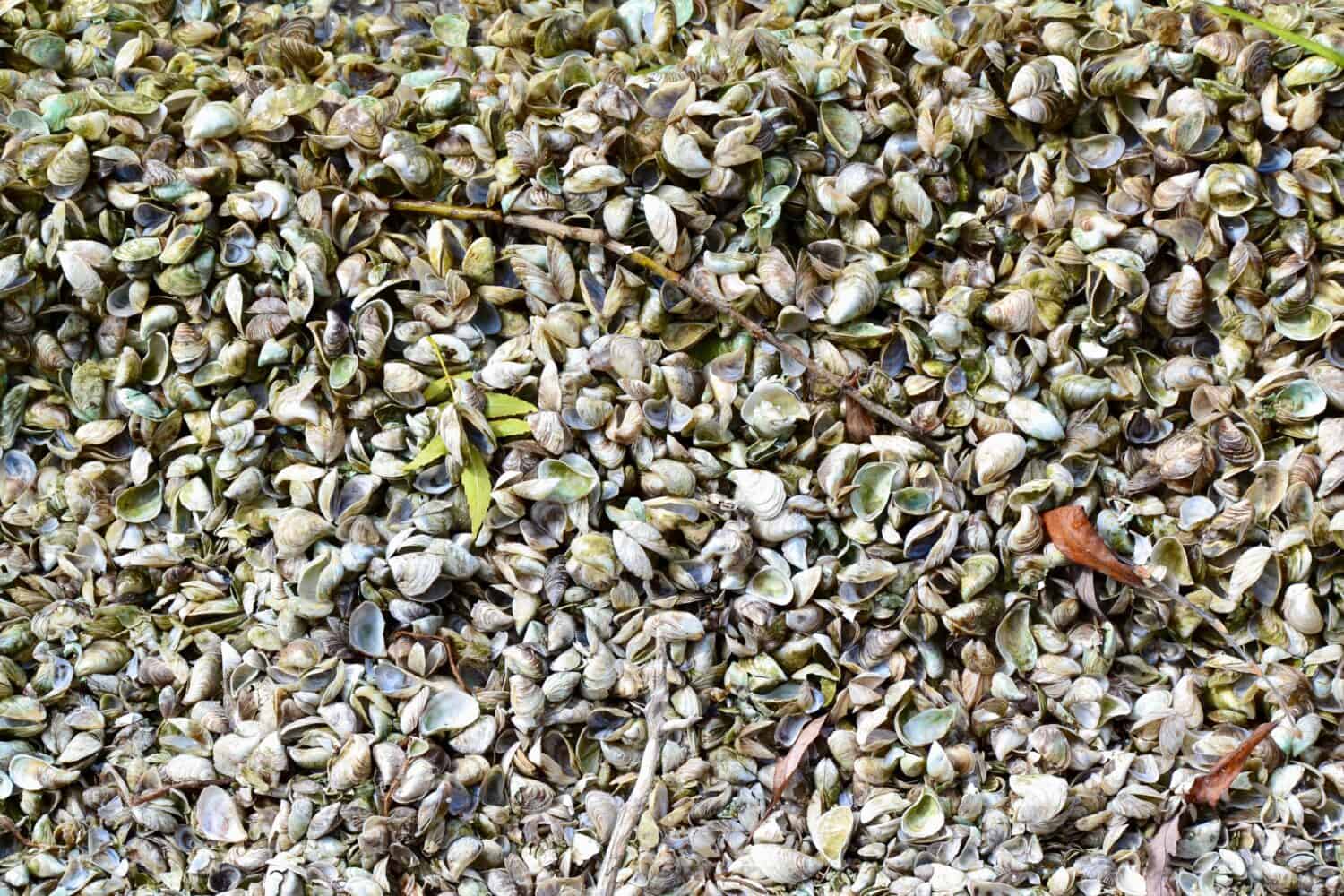
Quagga mussels are an invasive species across North America.
©Chris Dale/Shutterstock.com
The quagga mussel, scientifically known as Dreissena bugensis, is a freshwater species that cannot survive in saltwater environments. However, it has managed to spread across North America after arriving on ships that traveled from other oceans around the world. The impact of these invasive mussels on aquatic ecosystems has been significant and harmful.
One major issue with quagga mussels is their ability to filter out phytoplankton from the water column. This means that they remove an important food source for many animals living in freshwater systems, such as fish and zooplankton. Additionally, this filtering action decreases the chlorophyll content of the water, which can have serious implications for photosynthesis and overall ecosystem health.
In addition to altering food webs within aquatic ecosystems, quagga mussels also pose a threat by fouling clean water sources. They attach themselves to underwater surfaces such as rocks or pipes and create dense colonies that can interfere with water intake processes such as screens or valves. This can cause problems for power plants or municipal water treatment facilities that rely on clean sources of surface water.
8. Zebra Mussel

Zebra mussel (Dreissena polymorph) is native to Europe and invasive in Indiana.
©iStock.com/VitalisG
A zebra mussel (Dreissena polymorpha) is a small freshwater mollusk that is native to the Black and Caspian Seas in Europe. It gets its name from the distinctive striped pattern on its shell, which resembles the stripes of a zebra.
Zebra mussels are invasive species and have been introduced into waterways around the world through human activities such as shipping and recreational boating. They can quickly reproduce and spread, causing significant ecological damage by outcompeting native species for resources such as food and habitat.
Additionally, their sharp shells can clog pipes, damage boats, and create hazards for swimmers. In Indiana specifically, zebra mussels have become a major problem in many lakes and rivers throughout the state over recent years, leading to efforts to manage their populations through various means, including chemical treatments and education campaigns aimed at reducing human transport of invasive species between bodies of water.
9. Bighead Carp
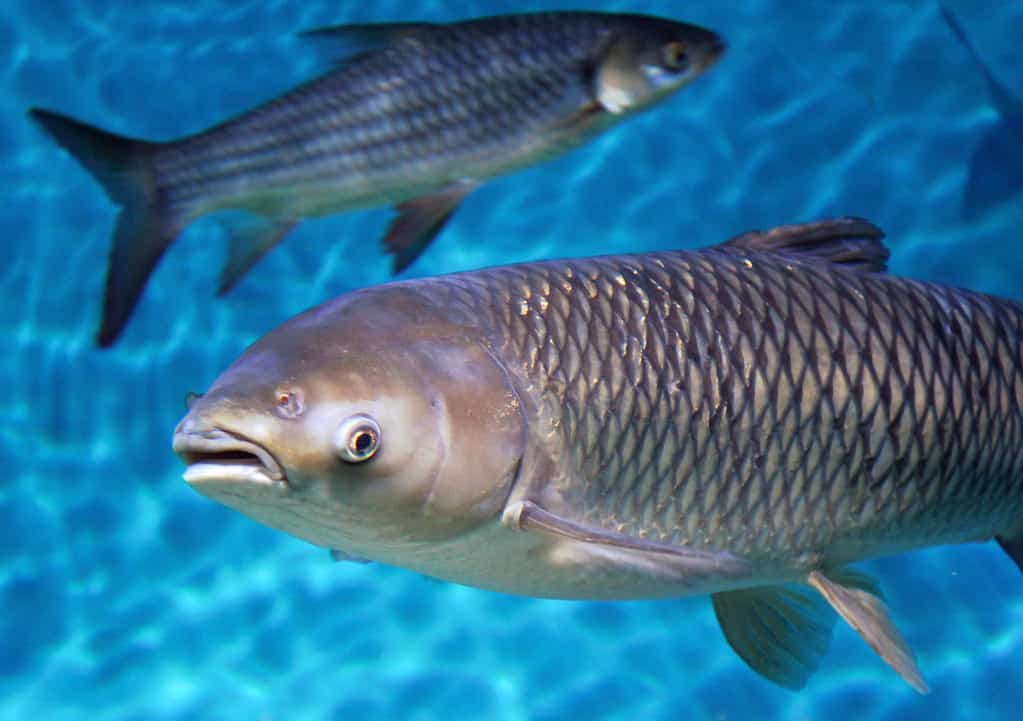
Bighead carp (Hypophthalmichthys nobilis) is an invasive species in Indiana’s waterways.
©Katoosha/Shutterstock.com
Bighead carp (Hypophthalmichthys nobilis) is an invasive fish species that originally hails from China and has become a significant problem in Indiana’s waterways. These large freshwater fish can grow up to four feet long and weigh as much as 88 pounds. They have distinctive blunt heads with eyes set low on their face, giving them a unique appearance compared to other fish species.
Unfortunately, bighead carp are known for their voracious appetite and rapid reproduction rates, which makes them incredibly difficult to control once they establish themselves in new environments. This poses a serious threat to native aquatic ecosystems because the bighead carp outcompete many local fish species for resources such as food and habitat. They are known to eat the plankton that native fish and mussels need to survive.
10. Round Goby
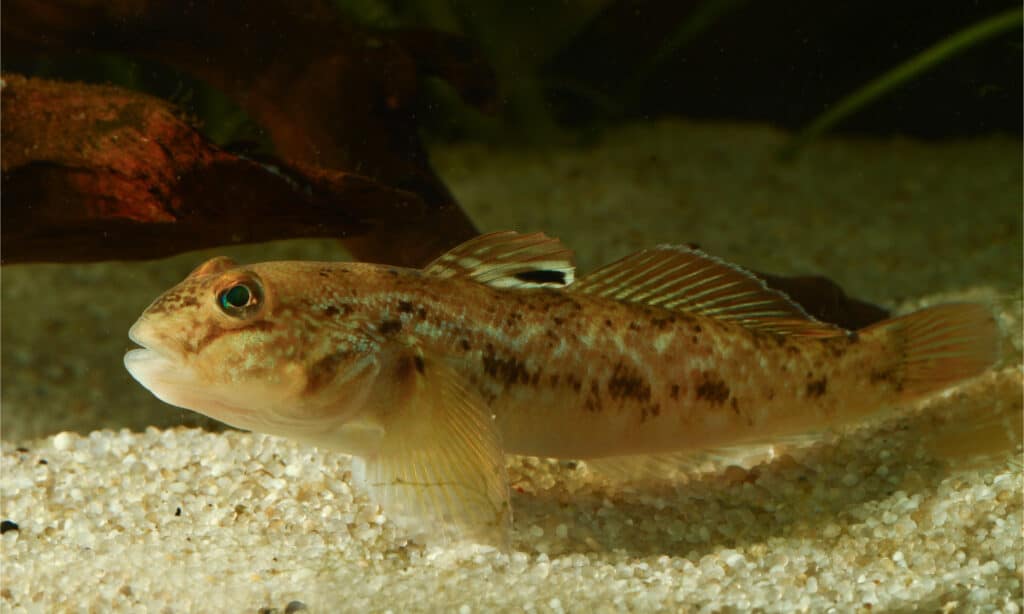
There are invasive colonies of round gobies in America’s Great Lakes.
©Geza Farkas/Shutterstock.com
A round goby (Neogobius melanostomus) is an invasive species of fish that has become a major problem in the Great Lakes region, including Indiana. Originally native to the Black and Caspian Seas, it was first discovered in North America in 1990 in Lake St. Clair near Detroit. Since then, it has spread rapidly throughout the Great Lakes via ballast water from ships and other means.
The round goby’s impact on the ecosystem is significant as they are voracious predators that feed on native fish eggs and compete with them for food and habitat. They also carry diseases that can infect other fish populations.
Despite efforts to control their population through various methods such as electric barriers or introducing natural predators like larger predatory fish into affected areas, the round goby continues to thrive and pose a threat to native aquatic life.
11. Ruffe
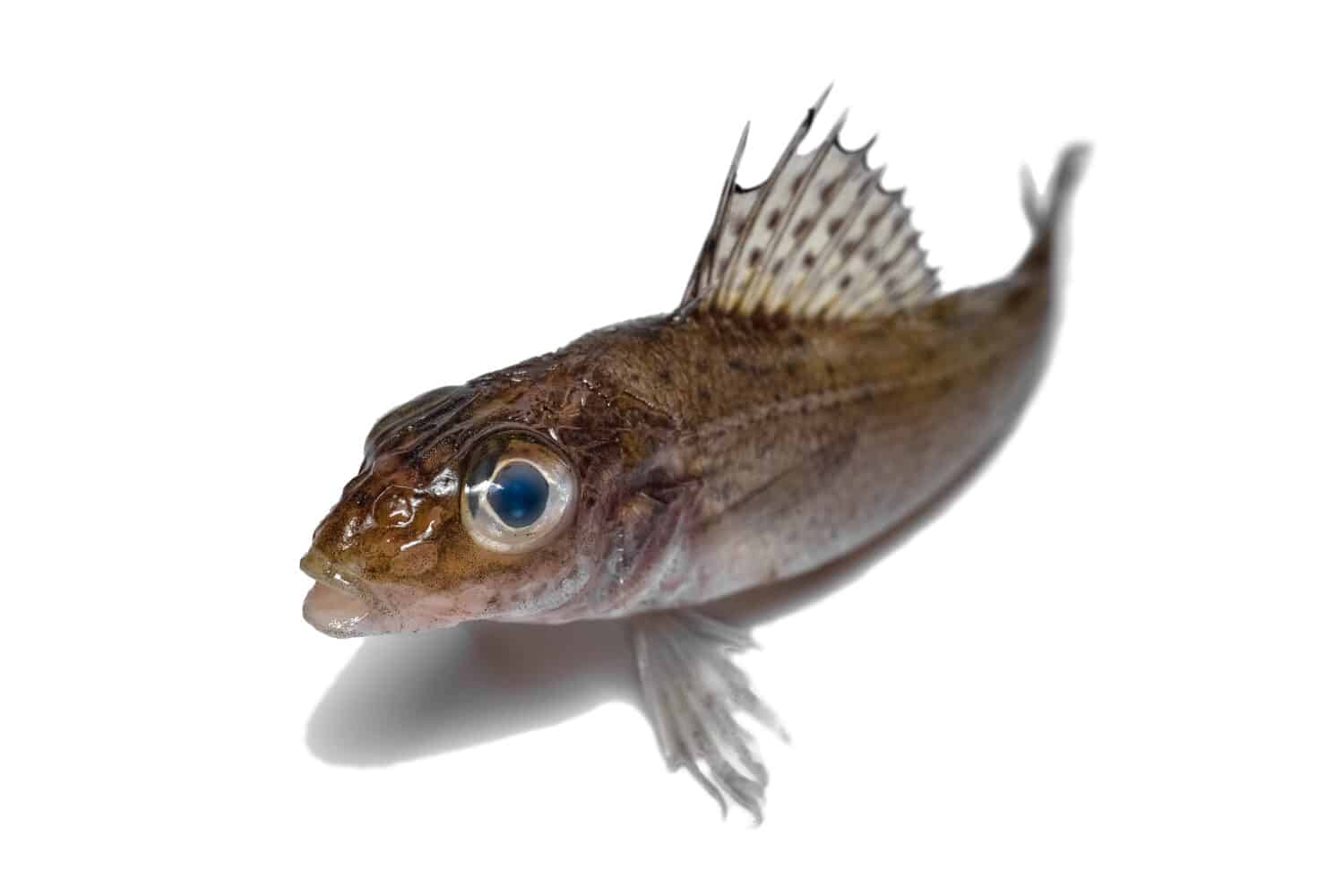
Ruffe are known for their aggressive behavior and ability to adapt quickly to new environments.
©Vovantarakan/Shutterstock.com
Ruffe (Gymnocephalus cernua) is a small freshwater fish that is native to Europe and Asia. It was first introduced to the Great Lakes in the 1980s through ballast water from ships that traveled from its native range. Since then, it has spread throughout the region, including Indiana’s waterways.
Ruffe are known for their aggressive behavior and ability to adapt quickly to new environments. They can outcompete native fish for food and habitat, leading to declines in populations of other species. Ruffe also has few natural predators in North America, further contributing to their rapid spread.
In addition to being a threat to aquatic ecosystems, ruffe fish are reducing populations of native yellow perch, trout-perch, and emerald shiners.
12. Northern Snakehead
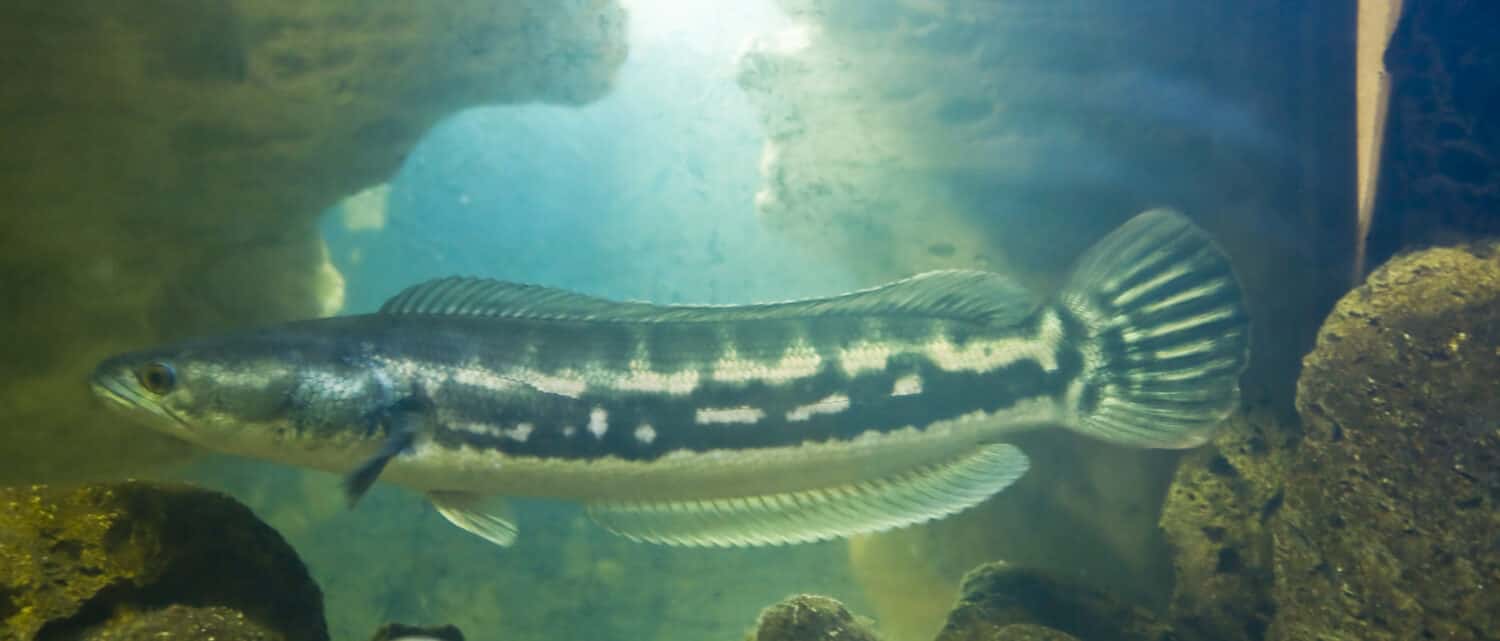
Northern snakehead fish are killing off native fish in Indiana.
©Irina Afonskaya/Shutterstock.com
The Northern Snakehead, scientifically known as Channa argus, is a predatory fish species native to parts of Asia and Russia. It has been introduced into various regions around the world through accidental or intentional release by humans. In Indiana, this invasive species has become a growing concern due to its potential impact on native aquatic ecosystems.
Also commonly referred to as the Amur snakehead or ocellated snakehead, this fish can grow nearly three feet in length and weigh over 15 pounds. Its appearance is characterized by a long cylindrical body with dark blotches on its sides and fins. The Northern Snakehead also possesses an elongated head with sharp teeth that are used for hunting prey, such as small fish, crustaceans, and amphibians.
Despite being prized for their taste in some cultures, these aggressive predators pose a significant threat to Indiana’s waterways by outcompeting native species for resources and altering food webs. Efforts are underway in the state to prevent the further spread of the Northern Snakehead through education campaigns and regulations on the possession and transport of live specimens.
13. White Perch
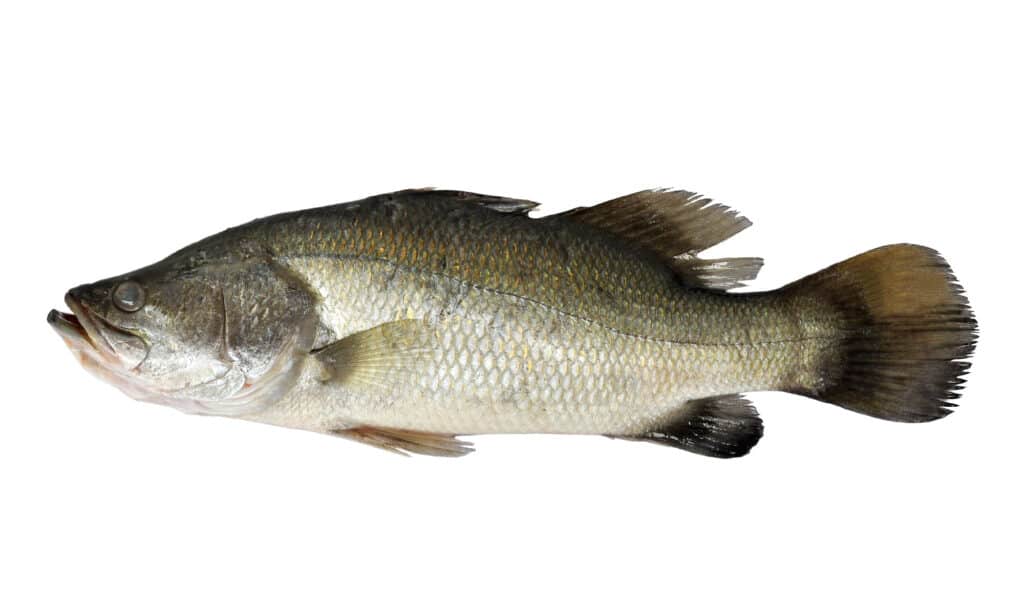
White perch usually weigh between one to two pounds.
©daagron/Shutterstock.com
White perch (Morone Americana) is a freshwater fish species that can be found in various water bodies across Indiana. The white perch has silvery-white scales and typically grows to be about 10-12 inches long, although larger specimens have been documented. While the white perch is not native to Indiana, it was introduced into the state’s waters via the Erie Barge Canal in the 1930s.
Despite its popularity among anglers, the white perch has become an invasive species in many of Indiana’s lakes and rivers. This is because it reproduces quickly and competes with native fish for food and habitat. White perch are also known to consume large quantities of zooplankton, which can negatively impact other aquatic life. They are voracious egg eaters and consume thousands of walleye and white bass eggs and minnows.
14. Feral Hog
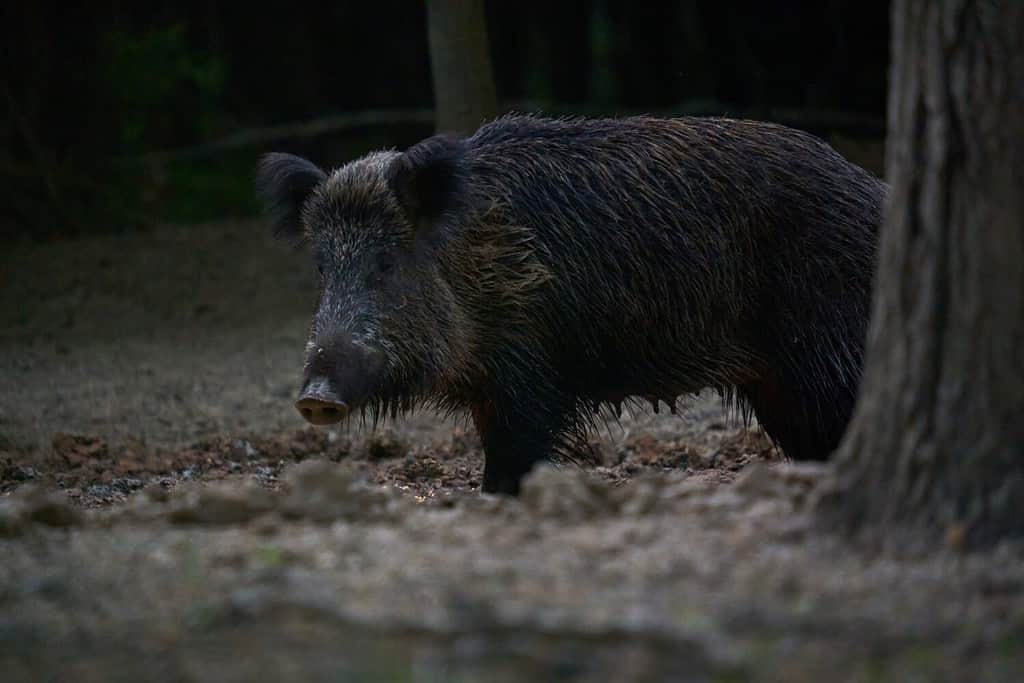
On average feral hogs are 5 to 6 feet long, measuring from snout to tail.
©Slatan/Shutterstock.com
A feral hog, also known as a wild hog or wild boar, is an invasive species that has become a significant problem in Indiana and many other states. These hogs are descendants of domesticated pigs that have escaped from farms or have been released into the wild for hunting purposes. They are highly adaptable and can thrive in various habitats, such as forests, swamps, and grasslands.
Feral hogs can cause extensive damage to crops, natural resources, and property. They are notorious for rooting up the ground with their snouts in search of food and destroying entire fields in the process. Additionally, they carry diseases such as brucellosis and leptospirosis, which can be transmitted to humans and livestock.
Attempts to control feral hog populations through hunting have proven unsuccessful due to their high reproductive rates – sows (female hogs) can give birth twice a year, with litters averaging 6-8 piglets each time. The most effective method of management is through trapping followed by euthanasia or relocation.
15. Mute Swan
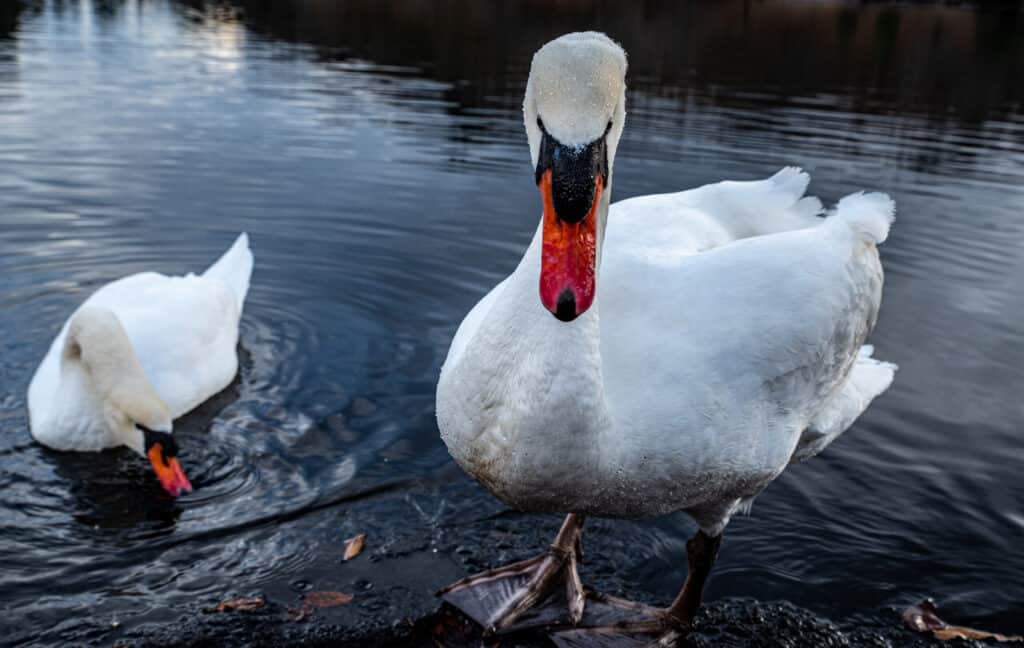
Mute swans are aggressive towards other waterfowl and can displace native species from their habitats.
©TETSU Snowdrop/Shutterstock.com
A mute swan, also known by its scientific name Cygnus olor, is a large water bird that is native to Europe and Asia. It has been introduced to various parts of the world as an ornamental species or for hunting purposes. The mute swan is easily recognized by its distinctive white feathers and long neck.
Despite their beauty, mute swans have become an invasive species in many areas where they have been introduced. They are aggressive towards other waterfowl and can displace native species from their habitats. Additionally, they consume large amounts of aquatic vegetation, which can lead to ecological imbalances in aquatic ecosystems.
In Indiana specifically, the Department of Natural Resources has implemented measures to control the population of mute swans due to their negative impact on local wildlife and habitats. These measures include egg-addling programs and relocation efforts aimed at reducing the reproductive success of this invasive species.
16. Nutria

Nutria are large invasive rodents
©Barbora Polivkova/Shutterstock.com
Nutria, scientifically known as Myocastor coypus, is a semi-aquatic rodent that originated in South America. Also commonly referred to as the coypu or river rat, nutria have become an invasive species in many parts of the world due to their high reproductive rate and lack of natural predators.
In Indiana specifically, nutria have been spotted in several counties along the Wabash River and its tributaries. These rodents can cause significant damage to wetland habitats by consuming large amounts of vegetation and burrowing into banks. This can lead to erosion and alter water flow patterns.
Nutria are also known carriers of diseases such as tuberculosis and leptospirosis, which can be transmitted to humans and livestock through contact with infected urine or feces.
Efforts are currently underway in Indiana to control nutria populations through trapping programs and public education campaigns aimed at preventing the further spread of this invasive species.
17. Asian Long-Horned Beetle
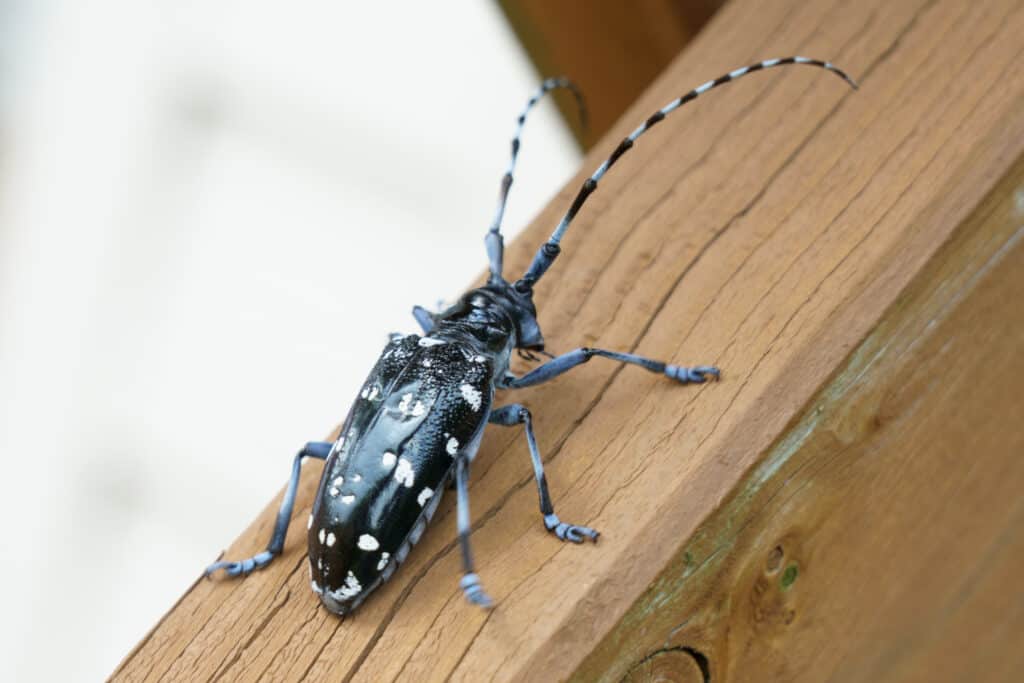
Asian long-horned beetles are highly destructive to trees are often classed as pests.
©High Mountain/Shutterstock.com
The Asian long-horned beetle (Anoplophora glabripennis) is a highly destructive invasive species that has caused significant damage to trees in many parts of the world. This large beetle, which can grow up to 1.5 inches long, has distinctive black and white markings on its antennae and body.
Originally from Asia, these beetles were first discovered in North America in 1996, likely arriving via wood packaging material or other commodities transported from infested areas overseas. Since then, they have spread rapidly throughout the United States and Canada, causing extensive damage to hardwood trees such as maple, birch, elm, and willow.
The Asian long-horned beetle lays its eggs inside the bark of host trees. Once hatched, the larvae tunnel into the tree’s wood, where they feed for several years before emerging as adult beetles. These feeding tunnels weaken the tree’s structure over time and can lead to branch dieback or even death of the entire tree.
18. Emerald Ash Borer
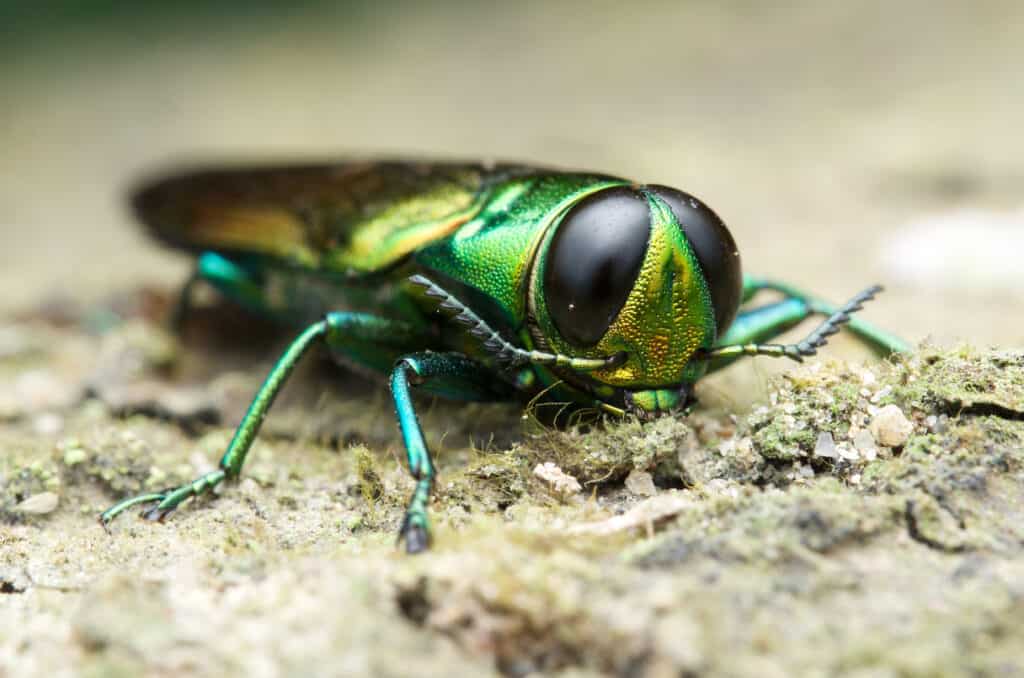
Emerald ash borers are beautiful but invasive species.
©Herman Wong HM/Shutterstock.com
The emerald ash borer (Agrilus planipennis Fairmaire) is a highly invasive species of beetle that has caused significant damage to ash trees throughout North America. Originally native to Asia, this small green beetle was first detected in Michigan in 2002 and has since spread rapidly across the continent, causing devastating effects on local ecosystems.
The emerald ash borer feeds on the inner bark of ash trees, disrupting their ability to transport water and nutrients. This can lead to the decline and eventual death of infected trees within just a few years. The economic impact of this pest is also significant, with billions of dollars spent by communities and governments to remove dead or dying trees from public spaces like parks and along roadsides.
19. Giant African Land Snail
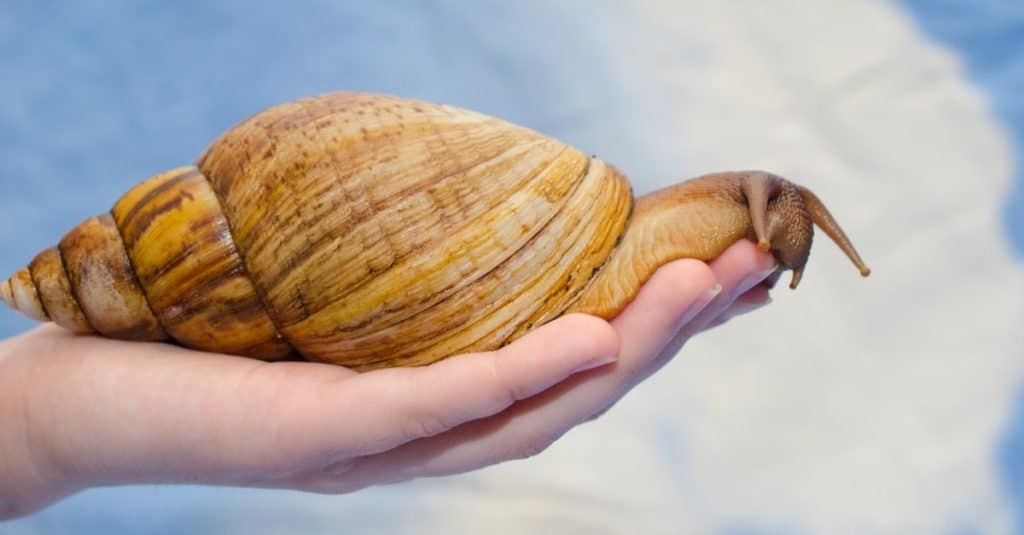
Giant African land snails are known for their hearty appetites. Caterpillars can completely defoliate a tree!
©Olena Kurashova/Shutterstock.com
The giant African land snail, also known as Achatina fulica, is a species of snail that is native to East Africa. However, it has become an invasive species in many parts of the world, including Indiana. This snail can grow up to 8 inches long and 4 inches wide, making it one of the largest terrestrial gastropods in the world.
One of the biggest concerns about this invasive species is its ability to reproduce quickly. The giant African land snail can lay up to 1,200 eggs per year and can reach maturity within six months. This means that populations can explode rapidly if left unchecked.
In addition to their rapid reproduction rate, these snails are also known for their voracious appetite. They consume a variety of plant matter and have been known to damage crops and gardens. They are especially fond of snacking on fields of cucumbers, peanuts, sweet peas, and beans. They can even damage the exterior of stucco homes!
20. Spongy Moth

Spongy moth, Lymantria dispar, was accidentally introduced to North America in the 1860s.
©iStock.com/Wirestock
A spongy moth, scientifically known as Lymantria dispar, is an invasive species that has been causing significant damage to forests and trees in Indiana. The adult female moths lay their eggs on the bark of trees during the summer months, which later hatch into larvae that feed voraciously on leaves. As they grow larger, these caterpillars can strip entire branches of foliage, leaving behind bare twigs and severely weakening the affected tree.
Spongy moths are native to Europe and Asia but were accidentally introduced to North America in the 1860s. Since then, they have spread rapidly across much of the United States and Canada through human activities such as trade or transport of goods and materials.
21. Spotted Lanternfly
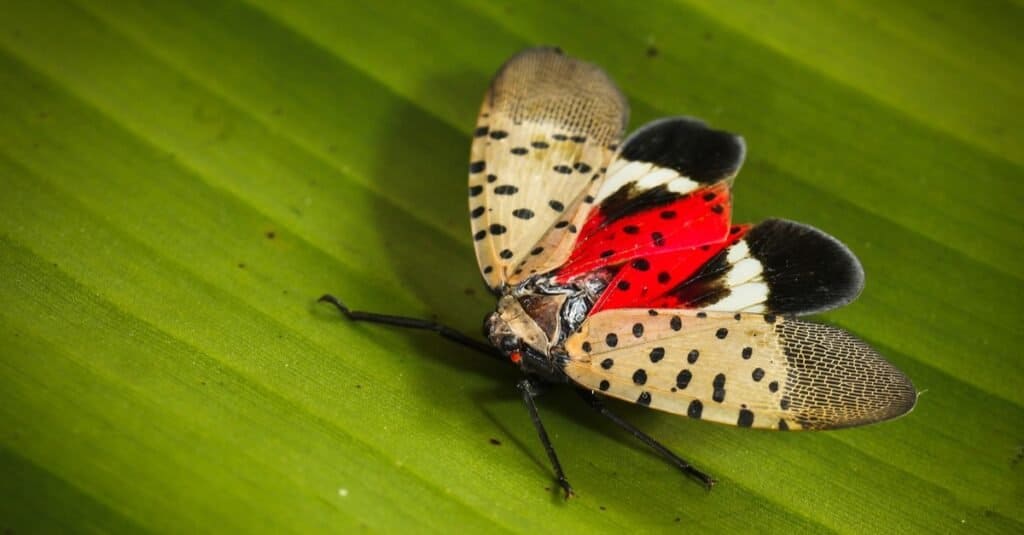
Spotted lanternflies are native to China.
©vm2002/Shutterstock.com
The spotted lanternfly, scientifically known as Lycorma delicatula, is an invasive species that has been causing significant damage to fruit trees and grapevines in parts of Pennsylvania, Virginia, New Jersey, and Delaware since 2014. In 2021 it was spotted near the Ohio River in Indiana.
This insect species is native to China but was unintentionally introduced into the United States through international trade. The spotted lanternfly feeds on the sap of various plants by piercing their bark with its mouthpart called a proboscis. As it feeds, the insect excretes honeydew which attracts other insects like ants and wasps that can spread disease-causing fungi. The infestation of spotted lanternflies results in stunted growth or death of affected trees and crops, leading to economic losses for farmers and orchard owners.
22. Amur Cork Tree
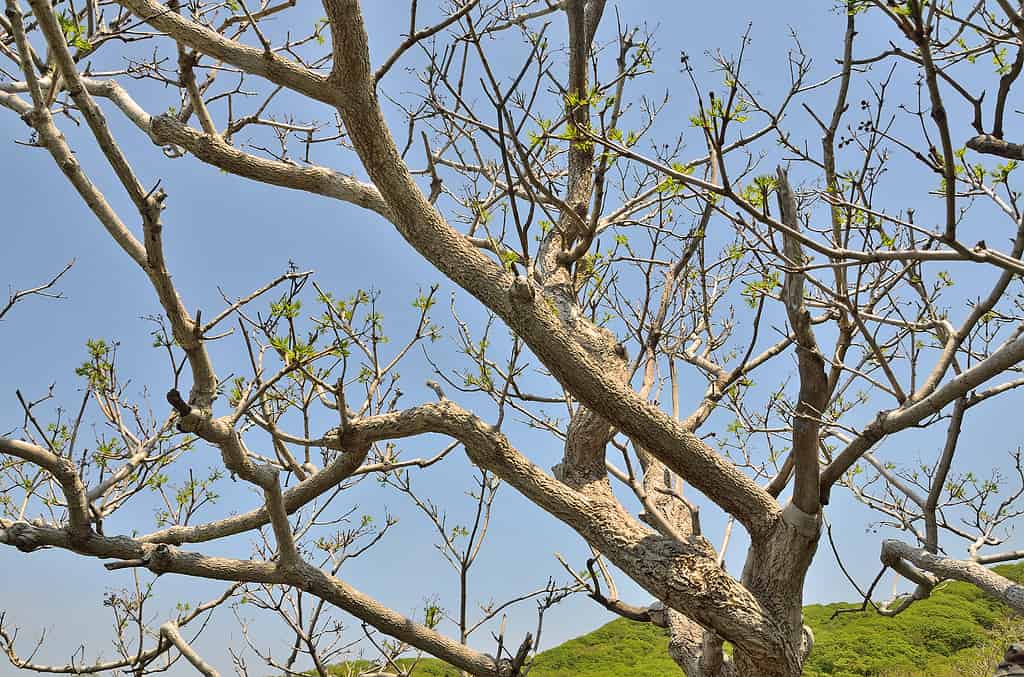
The Amur cork tree is an invasive species in Indiana.
©Ovchinnikova Irina/Shutterstock.com
The Amur cork tree, also known by its scientific name Phellodendron amurense, is a deciduous tree that is native to China, Japan, and Korea. It was introduced to North America in the mid-1800s as an ornamental plant due to its attractive foliage and ability to thrive in a variety of soil types.
However, over time it has become an invasive species in many parts of Indiana and other regions in North America. Amur cork trees can grow up to 50 feet tall with a broad canopy that shades out native plants below. They are able to spread rapidly through their prolific seed production and the ease at which they sprout from root fragments. They are known to shade out hardwood forests in Indiana.
23. Amur Honeysuckle
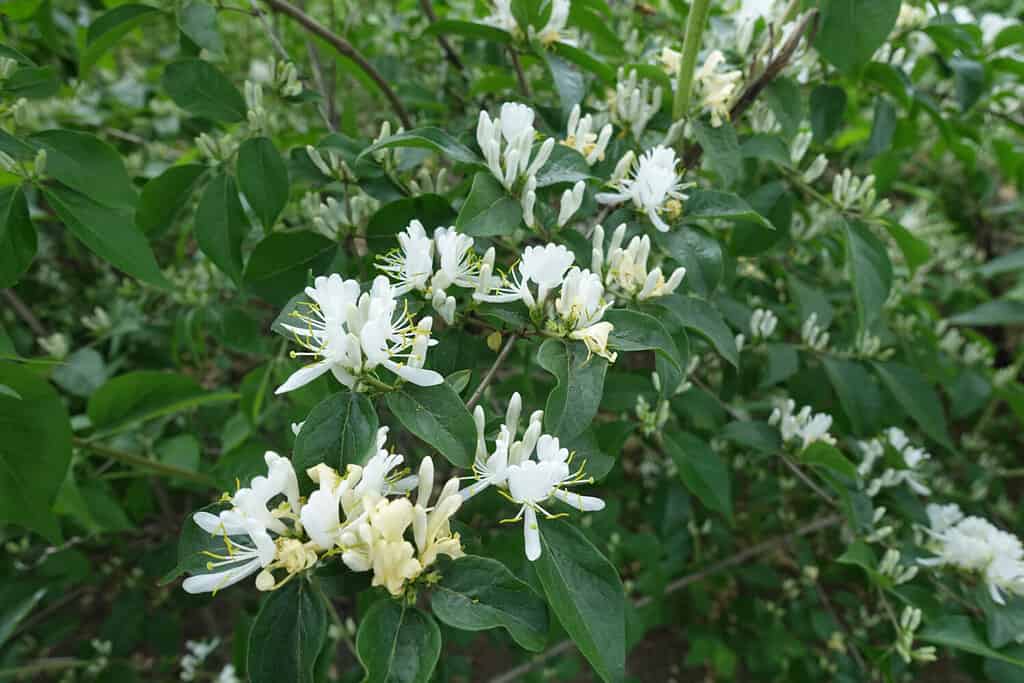
Amur honeysuckle has fragrant white or yellowish flowers in the spring but poses serious threats to biodiversity.
©APugach/Shutterstock.com
Amur honeysuckle (Lonicera maackii) is a species of invasive shrub that was originally introduced to the United States from Asia as an ornamental plant. It has since become a major problem in Indiana, where it out-competes native plants and disrupts ecosystems.
Amur honeysuckle typically grows up to 15 feet tall and produces fragrant white or yellowish flowers in the spring. Its leaves are oval-shaped and dark green, while its bark is light brown with distinct stripes. Despite its attractive appearance, amur honeysuckle poses serious threats to biodiversity by creating dense stands that prevent other plants from growing and providing little value for wildlife compared to native vegetation.
In addition, it can alter soil composition and nutrient availability, leading to further ecological disruption over time if left unchecked. To combat this invasive species, experts recommend removing amur honeysuckle manually or through herbicide treatment before replanting with diverse native vegetation that can better support local wildlife populations.
24. Mile-a-Minute Vine
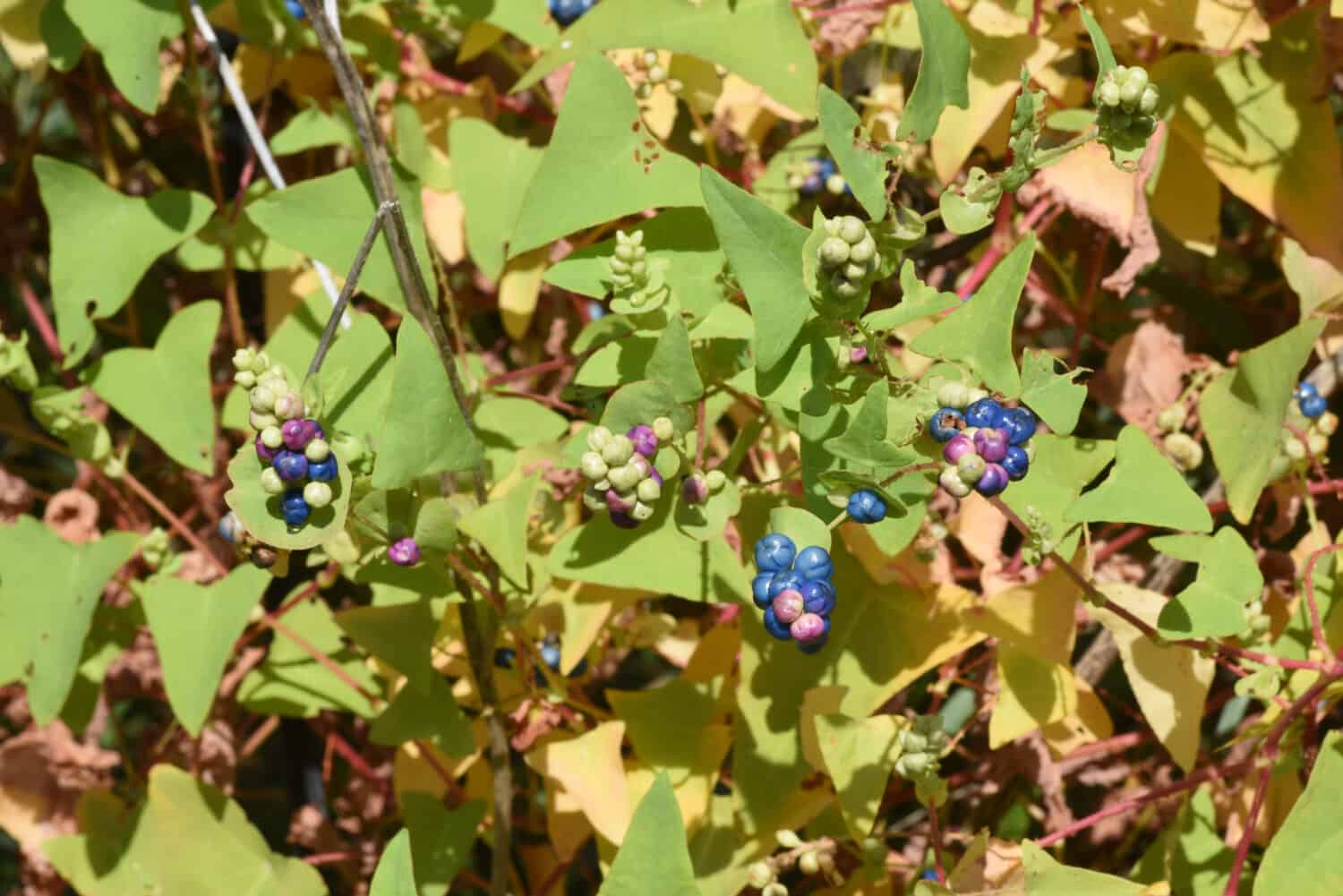
Persicaria perfoliata or mile-a-minute vine can grow up to six inches per day.
©tamu1500/Shutterstock.com
The mile-a-minute vine, scientifically known as Persicaria perfoliata but also referred to as Asiatic tearthumb, is an invasive species that has become a major concern in Indiana. This plant is native to Asia and was accidentally introduced to the United States in the 1930s through horticultural trade. The mile-a-minute vine can grow up to six inches per day, making it one of the fastest-growing plants in North America.
The leaves of this invasive species are triangular and alternate along its stem. They have small barbs on their underside that make them sticky and prickly when touched, hence their other common name, “tearthumb.” Its stems are thin and green with distinctive red-purple nodes. Mile-a-minute vines produce tiny white or pink flowers from June through September, followed by clusters of blue-black berries.
This aggressive vine can quickly overtake natural areas such as forests, wetlands, fields and disturbed sites like roadsides. It grows rapidly into dense mats smothering out any native vegetation beneath it, which limits biodiversity. Additionally, these vines can create safety hazards if they climb onto trees or structures, weighing them down, causing damage, or even collapsing.
25. Poison Hemlock
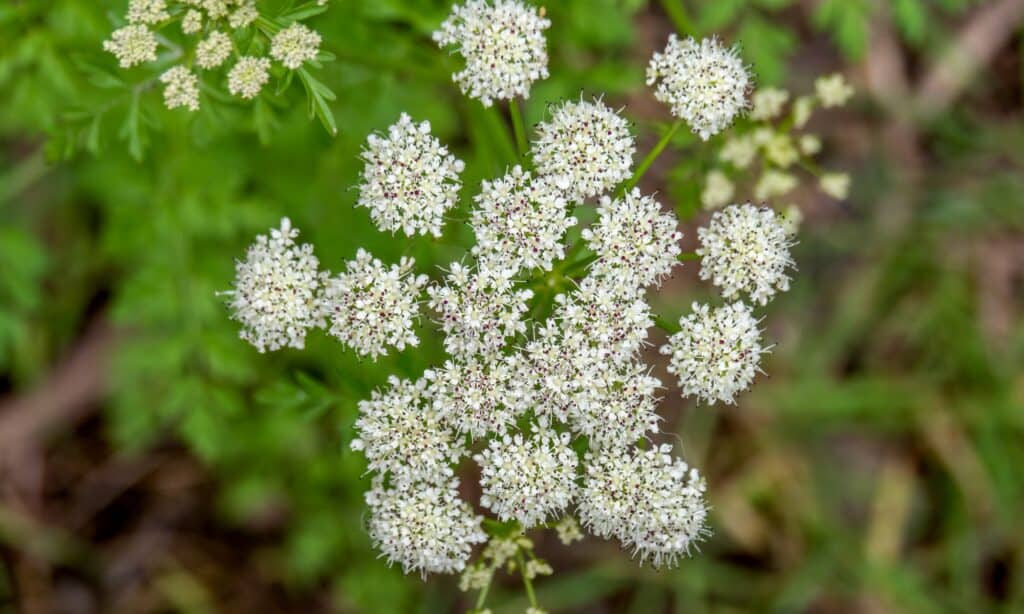
Poison hemlock looks very similar to wild carrots.
©iStock.com/Goldfinch4ever
Poison hemlock (Conium maculatum) is a highly toxic invasive plant species that was originally brought to North America from Europe in the early 1800s as an ornamental garden plant. It has since spread rapidly throughout Indiana and other parts of the United States, often invading fields, pastures, roadsides, and disturbed areas.
The poison hemlock plant can grow up to eight feet tall with hollow stems that are covered in purple spots or blotches. The leaves are fern-like and glossy green, while the flowers form small white clusters at the top of each stem. Poison hemlock is known for its foul odor.
All parts of the poison hemlock plant are poisonous, particularly when ingested by humans or livestock. The toxins present in this invasive species can cause respiratory failure and death if consumed in large enough quantities. Even minimal contact with the sap or leaves can lead to skin irritation or allergic reactions.
26. Wintercreeper
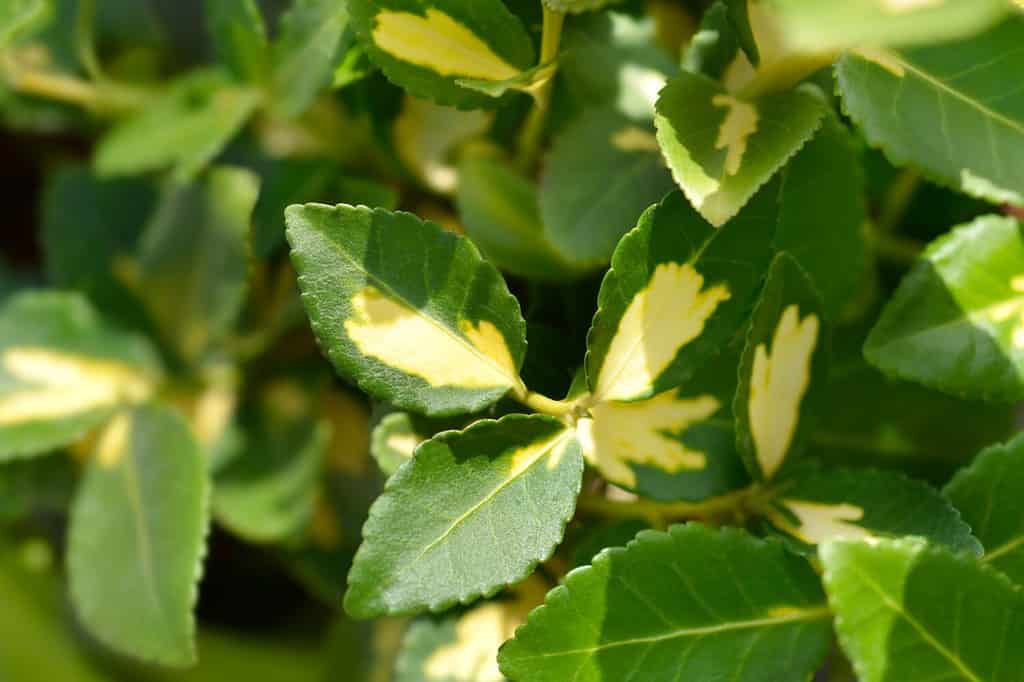
Wintercreeper is an invasive species of plant in Indiana.
©Nahhana/Shutterstock.com
Wintercreeper, also known by its scientific name Euonymus fortunei, is an invasive species of plant that has become a significant problem in Indiana and other parts of the United States. Originally from East Asia, this climbing vine was introduced to North America as an ornamental plant due to its attractive foliage and ability to grow quickly. However, it has since escaped cultivation and spread rapidly throughout forests, parks, and other natural areas.
One of the key characteristics of wintercreeper is its evergreen leaves which can range in color from dark green to variegated white and green. The plant can grow up to 70 feet long and will climb trees or structures if there is no support for it on the ground. Wintercreeper produces small clusters of flowers in late summer or early fall, followed by pink-red fruit capsules that split open when ripe.
The problem with wintercreeper lies in its aggressive growth habits, which allow it to outcompete native vegetation for resources such as light, water, and nutrients. This can result in a loss of biodiversity as well as changes to ecosystem processes such as nutrient cycling and soil structure. In addition, wintercreeper poses a threat to wildlife habitat by creating dense thickets that are difficult for animals to move through.
| Aquatic Plants | Scientific Name | Origin | |
|---|---|---|---|
| 1. | Asian Marshweed | Limnophila sessiliflora | Southeast Asia |
| 2. | Brittle Water Nymph | Najas Minor | Europe, Asia, and Africa |
| 3. | Chinese Water Spinach | Ipomoea aquatica | Southeast Asia |
| 4. | Duck Lettuce | Ottelia alismoides | Southeast Asia, China, India, and Australia |
| 5. | Flowering Rush | Butomus umbellatus | Europe and Western Asia |
| Aquatic Invertebrates | Scientific Name | Origin | |
|---|---|---|---|
| 6. | Asiatic Clam | Corbicula fluminea | Asia |
| 7. | Quagga Mussel | Dreissena bugensis | Ukraine and Russia |
| 8. | Zebra Mussel | Dreissena polymorpha | Black Sea and Caspian Sea |
| Fish | Scientific Name | Origin | |
|---|---|---|---|
| 9. | Bighead Carp | Hypophthalmichthys nobilis | China |
| 10. | Round Goby | Neogobius melanostomus | Black Sea and Caspian Sea |
| 11. | Ruffe | Gymnocephalus cernua | Europe and Asia |
| 12. | Northern Snakehead | Channa argus | Asia and Russia |
| 13. | White Perch | Morone Americana | Atlantic Coast |
| Terrestrial Vertebrates | Scientific Name | Origin | |
|---|---|---|---|
| 14. | Feral Hog | Sus scrofa | North America |
| 15. | Mute Swan | Cygnus olor | Europe and Asia |
| 16. | Nutria | Myocastor coypus | South America |
| Terrestrial Invertebrates | Scientific Name | Origin | |
|---|---|---|---|
| 17. | Asian Long-Horned Beetle | Anoplophora glabripennis | Asia |
| 18. | Emerald Ash Borer | Agrilus planipennis Fairmaire | Asia |
| 19. | Giant AFrican Land Snail | Achatina fulica | East Africa |
| 20. | Spongy Moth | Lymantria dispar | Europe and Asia |
| 21. | Giant African Land Snail | Lycorma delicatula | China |
| Terrestrial Plants | Scientific Name | Origin | |
|---|---|---|---|
| 22. | Amur Cork Tree | Phellodendron amurense | China, Japan, and Korea |
| 23. | Aur Honeysuckle | Lonicera maackii | Asia |
| 24. | Mile-a-Minute Vine | Persicaria perfoliata | Asia |
| 25. | Poison Hemlock | Conium maculatum | Europe |
| 26. | Wintercreeper | Euonymus fortunei | East Asia |
The photo featured at the top of this post is © Tina Khruslova/Shutterstock.com
Thank you for reading! Have some feedback for us? Contact the AZ Animals editorial team.






